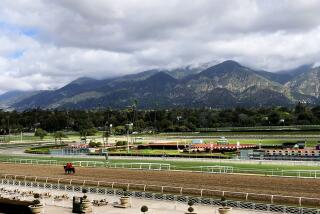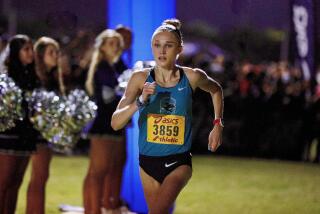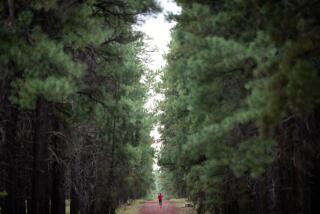Carlsbad 5,000 Running On Right Course : Track: Director’s dream comes of age after major revision.
- Share via
CARLSBAD — That slice of humble pie race director Tim Murphy swallowed 5 1/2 years ago had an pleasant aftertaste.
In the fall of 1985, Murphy, dreaming dreams of a wide-eyed child, called a hotshot advertising friend in New York with a pitch for a world-class 10K road race in Carlsbad.
“I kept calling her,” Murphy said. “Finally she told me, ‘Look, you’re a nice guy, Tim, so I’ll talk to you, but don’t you ever send me a proposal telling me you’re going to put on the best 10K in the world in a place I’ve never heard of. You’re never going to do it in a place that’s not a major market, and especially not in a place no one’s ever heard of.’ ”
Undaunted, Murphy didn’t ditch the dream, he merely revised it. His love child, the Carlsbad 5,000, became one of the largest--certainly the most heralded--5,000-meter races in the world.
The day after the conversation with his ad friend, Murphy decided he needed a gimmick that would leave the running world reeling.
“When I got to my office,” Murphy said, “I called the national record place to see what the world record was in the 5K. It was so soft, it was ridiculous.”
On the assumption that 5,000 sounded more prestigious than 5K, Murphy had a name and a distance for his race. The next priority was a course. So he called Steve Scott for help.
“I didn’t really know Steve,” he said. “I called him cold. He loved the idea because he hates 10Ks, and this would be prize money on a road distance that theoretically he could win.”
Scott of Leucadia and New Zealand Olympic champion John Walker, two of the most famous milers in history, got a good laugh after they ran the course Murphy had designed.
“They ran it, came back to the race committee and said it was the most stupid course they’d ever seen,” Murphy said. “They said it needs to be on the coast, then turn around in the street.”
Sunday marks the sixth running on Scott’s suggested course, which is as scenic as it is fast. Carlsbad has been the site of 40 of approximately 175 national single age-group records, the unofficial world bests in the men’s and women’s invitationals and the largest masters’ field in the world. Of 1990’s top 10 men’s times, six came at Carlsbad. Among the women, five of the top 10 were run at Carlsbad.
From its inception, the race has been remarkably successful as an invitational and a people’s road race.
“Carlsbad certainly was the front-runner,” said Linda Honikman, one of the managing trustees of Tacstats, the running world’s answer to baseball’s Elias Sports Bureau. “It had a lot to do with the competitive growth of the 5K and its popular growth as a participatory distance.”
Only a handful of elite 5Ks have popped up across the country recently, including the Rogaine 5K of Chicago and Los Angeles, which were staged in conjunction with the Chicago and Los Angeles marathons for the first time this year. Honikman said only 10 elite 5K races exist worldwide, including Freihofer’s in New York, a women-only race with tradition.
Weekend warriors and world-class athletes alike flock to Carlsbad the way the swallows return to Capistrano. Runners, experts and assorted others have theories why the race has such appeal.
Three-time winner Scott said, “The quality of the field has always been extremely deep and talented. You can always count on the Kenyans, the Mexicans, the Russians or some Olympic champions coming in and making the field tremendously deep. From that standpoint, it’s always been a great race.”
ESPN has made this year’s 5,000 its Road Race of the Month, and the show’s commentator, Toni Reavis, said Scott himself attracted other big names in the race’s formative years.
“Tim (Murphy) has wanted to have a quality race and Steve used his prestige to get it,” Reavis said. “They started it, and they’ve been able to maintain it.”
Agent Bob Wood, whose clients include Doug Padilla, the defending Carlsbad champ and American indoor record holder at 3,000 meters, said Carlsbad offers more opportunities than a high-profile marathon, where the spoils belong only to the victors.
“There are certain races that if you win, it helps you’re marketability,” he said. “If you don’t win, no one remembers who came in second. But in the case of Carlsbad, even if you don’t win, you can get something from it. It’s on ESPN, so maybe someone is watching you. Or if you run fast, a fast time can guarantee you appearance money or a spot in another race.”
Wood said the distance is appealing because runners can race more often at 5,000 meters.
“An elite can run more (5Ks) than 10Ks or marathons,” he said. “You can run a 5K every weekend. It’s an intermediate distance for big-time milers, yet road runners and some marathoners can drop down and do well. The distance itself is a magic number.”
Matt Clayton, former San Diego State standout and cross county All-American, primarily runs 10Ks up to marathons, but likes the 5,000 as a chance to test himself against specialists at other distances.
“Milers and 10,000 runners are meeting halfway,” he said. “It’s a good opportunity. A good 10K runner can run a good 5K, and a miler can run a good one, too. It synthesizes the two. It’s only 13 minutes, so it combines both speed and strength. And it’s only three miles, so joggers as well as world-class athletes can handle it.”
That the race is “spectator-friendly” is another reason why Carlsbad has mass appeal, Clayton said.
“The people who want to stay and watch don’t have to hang around 45 minutes after they’ve run,” Clayton said. “It’s good for the spectator. And (with the turns) they can see the whole thing. It’s a happening.”
Said Murphy: “There’s nothing like running with people cheering you on.”
More people aren’t simply watching, either. They’ve taken a liking to the distance and are pounding the pavement at 5K.
In 1990, Tacstats estimated there were 3,480 10K races with 1,000,208 participants, an increase of 3.9% from 1989. The increases at the 5K distance were dramatically higher. Tacstats estimated 583,000 runners took part in 3,360 races, an increase of 11.7% from 1989. In the previous year, there was a 33.6% increase.
By comparison, marathon racing grew by 5.9% last year, and participation in half marathons decreased 2%.
“The 5K is the fastest-growing distance,” Reavis said. “The running boon was built on the back of the longest distance, when (marathoners) Frank Shorter, Bill Rodgers and Alberto Salazar were popular. Everyone wanted to start with that. But now, the 5K is a natural reaction to people who don’t have the time to train so many hours.”
Carlsbad already snared the top spot as the largest masters race in the country. Last year, the Charlotte Observer Masters 10K drew 969 entrants before Carlsbad drew 1,586 in the 40-and-older category.
Murphy says the capacity is 8,000 for the three people’s races. This year, 5,100 runners registered for the race, compared with 4,500 last year.
Reavis says speed begets speed, and annual fast times on the North County course also peak interest.
“People have run fast on (the course), so its past is an allure to its future,” he said. “There are people to pull you out front.”
Six of eight major records were set at Carlsbad: male junior, open and all-comers and female junior, masters and all-comers.
Timing is another key factor, Reavis said.
“You couldn’t ask for a better time of year,” he said. “The only other major race staged around the same time is Boston (the Boston Marathon, April 19), and that’s on another coast and at a completely different distance. The same people aren’t running these races, so it doesn’t dilute the talent.”
More to Read
Go beyond the scoreboard
Get the latest on L.A.'s teams in the daily Sports Report newsletter.
You may occasionally receive promotional content from the Los Angeles Times.







